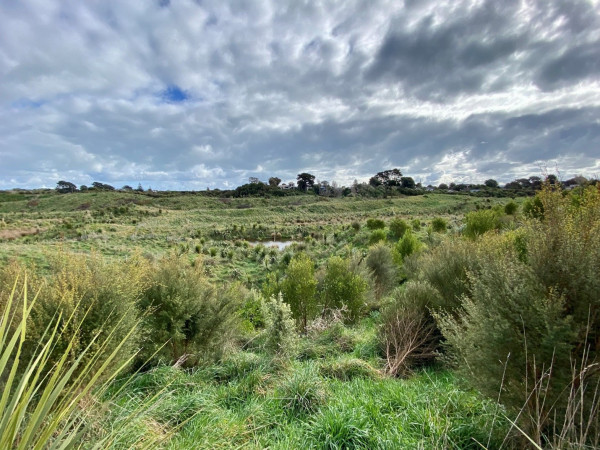What’s happening in Queen Elizabeth Park?
There’s a lot happening in the park to support people’s recreation enjoyment and restoration of the environment.
At the heart of the vision for restoring the environment of this and other parks is partnerships with mana whenua and collaborations with community.
Toitū Te Whenua Parks Network Plan 2020-2030 (Toitū Te Whenua) is our Reserves Act statutory management plan. Its vision is ‘Restoring healthy ecosystems for the benefit of people and nature’. To do this it provides policy directions and identifies many actions for work over the coming years. These pages outline some of the work that has been taking place on plan actions since 2020 and also ongoing volunteer programme work contributing to restoration and recreation in the park. You can read Toitū Te Whenua here if you're interested.
We are grateful for the work of volunteers who help in kaitiaki and manaaki, guardianship and support activities of the land or whenua, and education activities in parks. Restoration activities and working more with communities are the core focus of this Plan because ‘He waka eke noa, we’re all in this moving forward together’. You can read about the great conservation and restoration work taking place in the park below.
What's in a name?
Queen Elizabeth Park (QEP) lies between two main streams or ‘awa’, the Whareroa and Wainui. Whareroa means ‘long meeting house’ and Wainui means an abundance of water. For mana whenua and others, the park and the broader area are known as ‘Whareroa’. Restoring the environment to better states of health and biodiversity are the focus of a lot of work in the park, including wetland rewetting work which will see some of the previous ‘abundance of water’ returned.
There is action in Toitū Te Whenua (Action A356) to work with mana whenua to identify a new name for the park through statutory processes. Restoring other original place names within the park is important too.
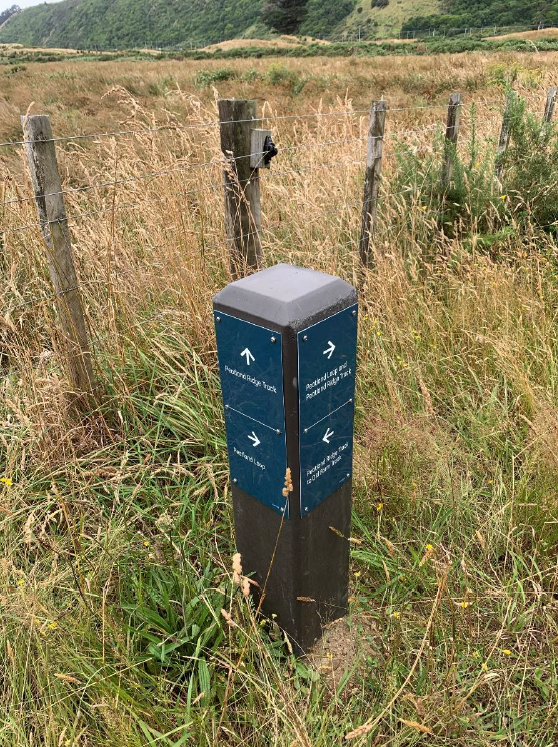
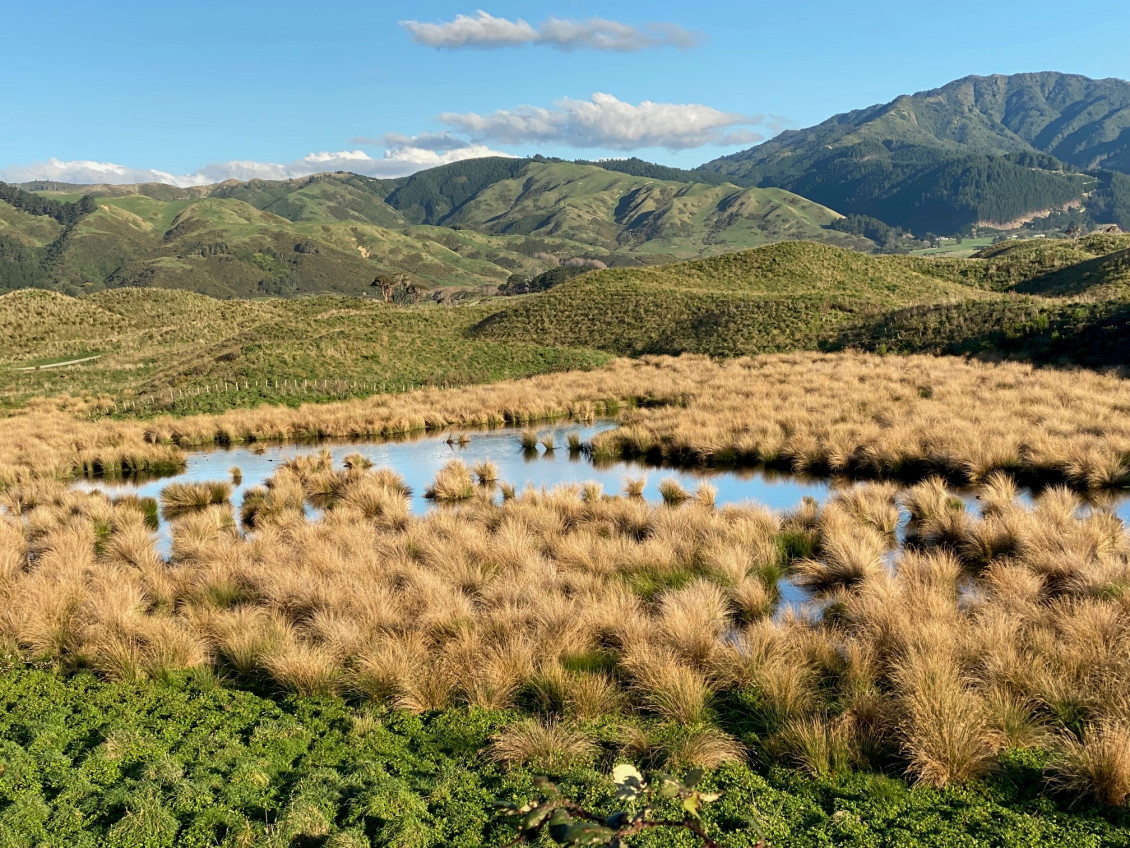
Since commercial grazing ended the formerly grazed areas of QEP are showing remarkable recovery through natural processes of restoration and a lot of restoration work by many people. Our park rangers have been busy implementing the actions of Toitū Te Whenua (Parks Network Plan) and making a lot of access and recreation activity improvements.
Access improvements
Redundant fences and gates have been removed and recycled, and many new trails opened for shared use. This is making access a lot easier, and the landscape feel more ‘park’ and less ‘farm’ like. New trails have been opened through the northeastern wetlands. You can now walk or ride circuit trails through this area including the Peatland Loop, Peatland Ridge Track and the Old Farm Track through the centre of the park. Other trails through the northwestern dune wetlands will be progressively upgraded for walking and riding too. You can explore these areas now.
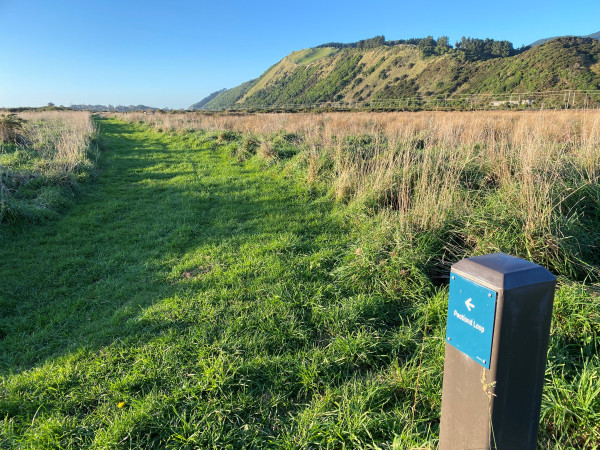 |
 |
| The northern Peatland Loop provides great views of restoration plantings and is suitable for walkers, dog walkers, horse and bike riders. The park now has an open landscape feel after the fences and gates previously required for commercial stock and horse grazing were removed and recycled. A bridle trail has been created beside the Te Ara o Whareroa cycle trail by moving the Kāpiti Pony Club area fence line inwards. Remember to keep dogs on leads on this busy shared trail. Fence removal is ongoing and will take a number of years. | |
Dog walking access
QEP is now a dog walker's paradise. Almost the whole park is open for dog walking on-lead and there are many off-leash areas as well. To protect bird habitat dog walking is not permitted along Te Ara o Tipapa (wetland walk), and the connecting Dune Swamp Loop tracks south of Whareroa Road, near the Mackays Crossing. Remember to pick up your dogs’ poo and place it in the bins provided or take it home with you.
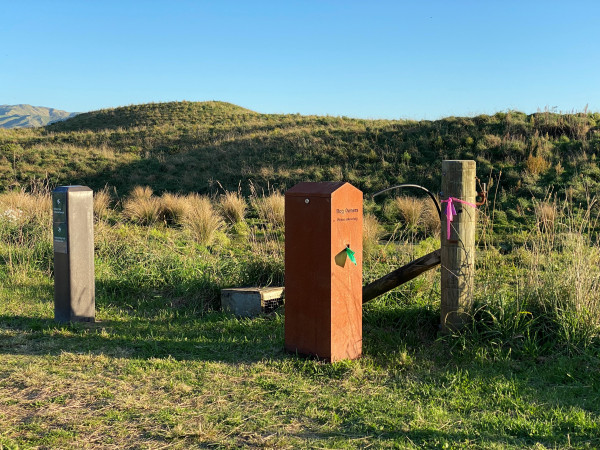 |
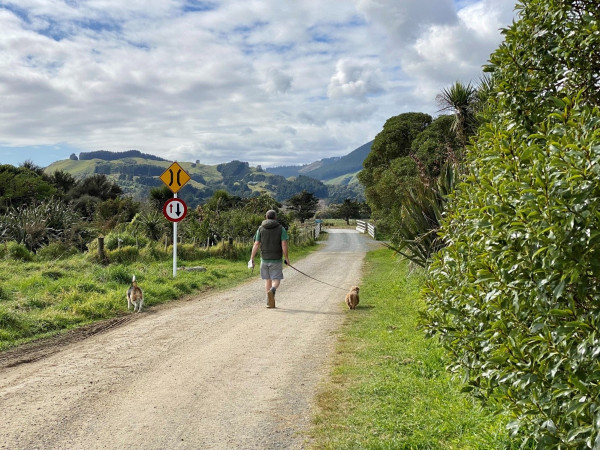 |
| There are poo bins throughout QEP. All the trails are shared so keeping dogs on lead is safest for everyone, particularly along the busy Te Ara o Whareroa cycleway. | The Old Farm Track runs north south from Whareroa Road to Poplar Avenue. You can see a lot of the great wetland restoration work on either side of this trail. It’s shared with horse riders and bike riders so it’s best to keep your dogs on a lead. |
Horse riding
The fence has been relocated beside the Kāpiti Pony Club area and the Te Ara Whareroa Trail to enable a new bridle trail to be created. The ‘Old Farm Track’ through the centre of the northern park from Whareroa Road north to Poplar Avenue is fully open for all park users. The Peatland Loop is open for horse riding along with the Kānuka Track and a link track to Te Ara Whareroa Trail.
The park is open for casual horse riding and there is good float parking via the Mackays Crossing entrance. More float parking is planned at a new park entry off Poplar Avenue which will progressively be developed. Horse poo isn’t pleasant for other trail users to come across and it’s difficult to avoid on narrow trails. If your horse does a poo on a trail, please move it off the trail.
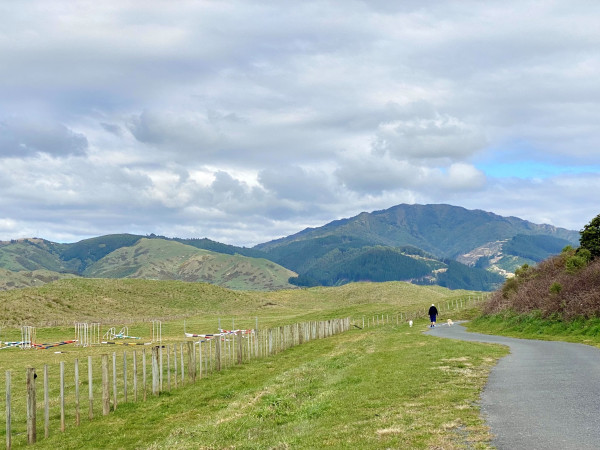 |
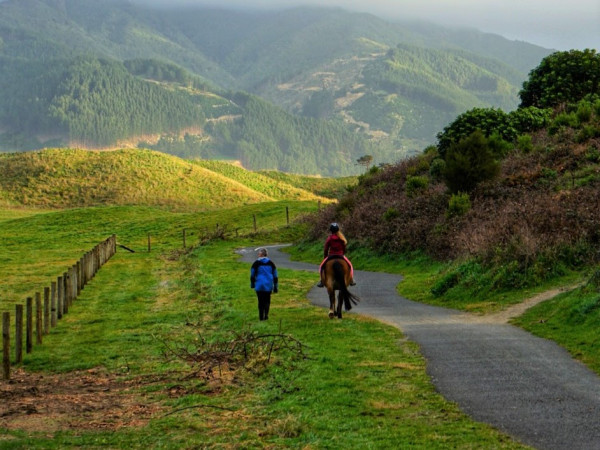 |
 |
 |
| Moving a fence beside the cycle way has created a bridle trail enabling more circuit track riding options. Gates and fences are progressively being removed throughout the park to make horse and bike riding access easier. | |
Other park upgrades and enhancements
Action A344 of Toitū Te Whenua identifies that we will develop or enhance ‘destinations’ in the park. Progress on this includes:
a. The Paekākāriki picnic area and storytelling about historic Camp Paekākāriki, former US Marines camp. The US Marines Trust with the assistance of Greater Wellington’s parks maintenance team has developed a new area of signs with historic information.
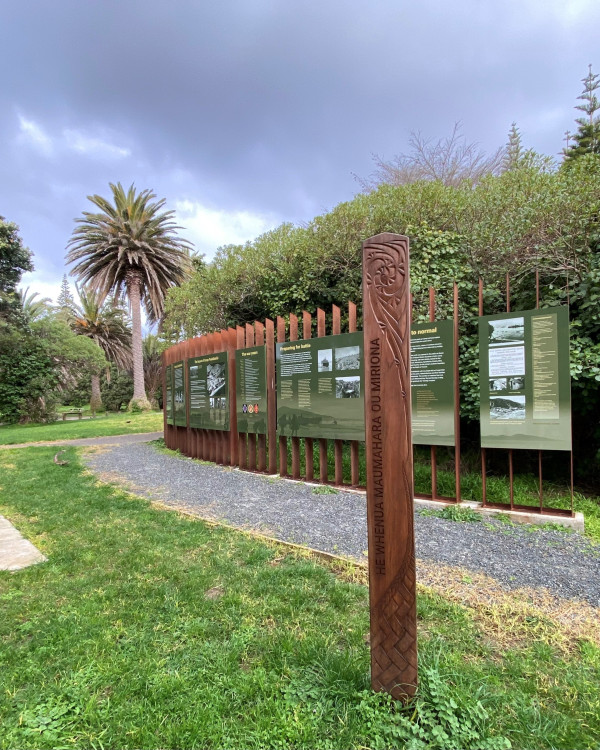 |
 |
| The US Marines Trust volunteer group has organised the development and installation of new signs about the former Camp Paekākāriki. A pou recognises Miriona Mutu Mira, granddaughter of Aperahama Mutu Mira, of local mana whenua Ngāti Haumia. | |
b. Development of a Raumati South entry and picnic area, ‘adaptively reusing park buildings. Connect to the progressively restored peat wetlands with circuit trails’. There are lots of new trails to explore in the northern park restoration areas and more of the former farm tracks are being upgraded as trails. This will include a trail in the eastern dune wetland area via the Maclean Trust. Works are planned to open a new park entrance and car park off Poplar Avenue and over time add picnic facilities here. The Kāpiti Pony Club is now using the former shearing shed and dairy area.
 |
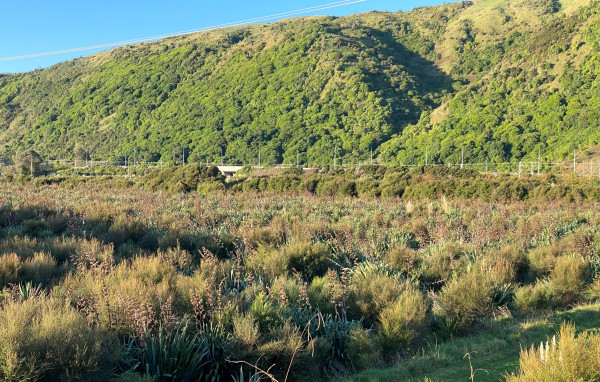 |
| There are well signposted, easy to follow new circuit tracks to explore the peatland restoration areas in the northern park. A lot of restoration plantings here have been funded by the McLean Trust. Development of more tracks to other wetlands within the dunes is planned. | |
c. Equestrian opportunities – Explore options through master planning for co-location and improvement of equestrian facilities for all groups to enhance the park as a casual riding and equestrian sports destination. Lots of trails have been opened for casual riding in the park and many gates and fences removed. Eventing Wellington’s area is being enhanced so that fixed jumps avoid wetlands. The new pony club area is now well established.
 |
| A new main entrance off Poplar Avenue in Raumati South is planned. There is a lot of work to do here to establish new facilities, but initial work will create a car and float parking area, but all the trails through the Maclean Trust restoration area are open now for you to explore. |
A further park planning process will see landscape concept plans developed for the park entry areas including Mackays Crossing, the new Poplar Avenue entrance and the Paekākāriki entrance area to accommodate changes due to ongoing coastal erosion. In QEP this process is being called Te Mahere Toitū Te Whenua (the plan for Toitū Te Whenua). In Toitū Te Whenua this is identified in Action A327 Develop a landscape master plan which will be developed in partnership with mana whenua and through Reserves Act public consultation processes, so it can be incorporated into the management plan. The process is also an opportunity to investigate possibilities for recreation activities such as camping and further trail connections or facilities.
He rau ringa e oti a, many hands make light work
Wetland and duneland native vegetation restoration work has been taking place in the park over many years, but efforts increased significantly after Greater Wellington adopted Toitū Te Whenua Parks Network Plan in 2020 and the focus shifted fully towards restoration of the natural environment and an end to commercial stock and horse grazing.
Many groups and individuals are doing great conservation work in the park. Collectively, with the help of mother nature and several wetter than usual summers and winters, the park landscape is transforming.
Mana whenua including the Rongoā Collective are actively involved in kaitiakitanga (guardianship or protection) activities.
In 2019 the Maclean Trust provided a very generous donation which enabled a large area of wetland restoration planting in the northern parts of the park. The Friends of QEP, Restoration Group, Kāpiti Biodiversity Project, Nursery Groups, mana whenua via the Rongoā Collective and Te Wānanga o Aotearoa, other conservation volunteers and local schools led much of the restoration work for many years and continue to make a significant contribution.
Restoration groups are restoring wetlands, improving natural habitats, creating eco-corridors, enriching the native plant mix in the park including secondary understory plantings and undertaking weed and pest animal work.
The Department of Corrections Community Service workers have also made huge contributions, doing hard mahi to remove redundant fences and gates, weed removal and plantings. This important restoration work is continuing.
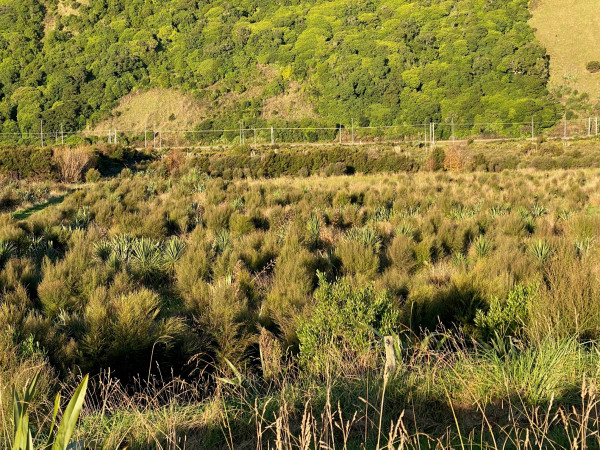 |
 |
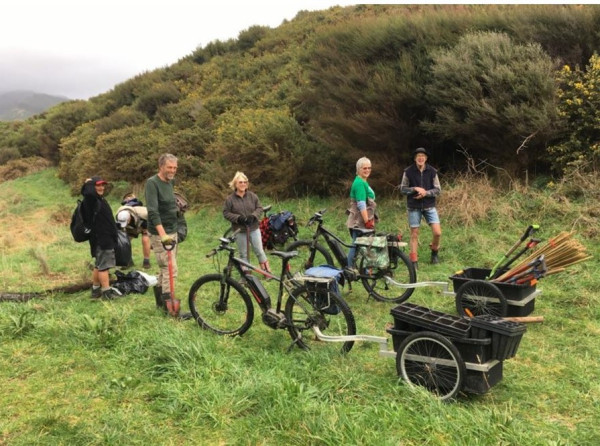 |
 |
| The Maclean Trust restoration area plantings in the northern park are now well established and all tracks are open. The Nursery Group ecosource seed from the Foxton Ecological District. Enrichment plantings have taken place in the dune swamp (bottom left photo S Kress) and fern birds / Mātātā which are classified as 'at risk - declining' have been sighted in the park in the restoration areas (photo Russel Bell). | |
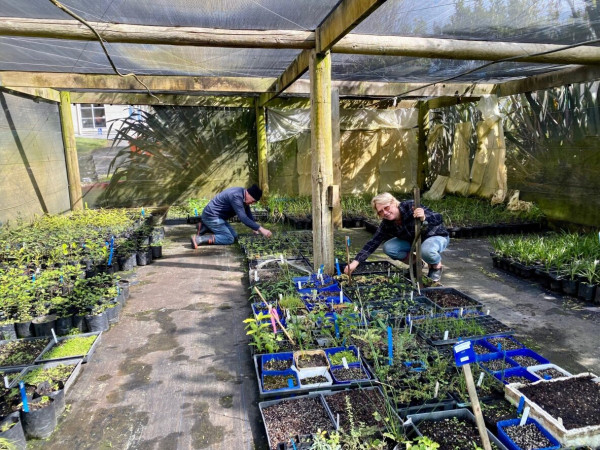 |
 |
| The park restoration vision is long term with many people helping. Pictured here are the Te Wānanga o Aotearoa Ōtaki campus volunteers on their way to a planting, and committed nursery group members Russell Bell and Pene Burton-Bell. All conservation efforts are valued and appreciated. | |
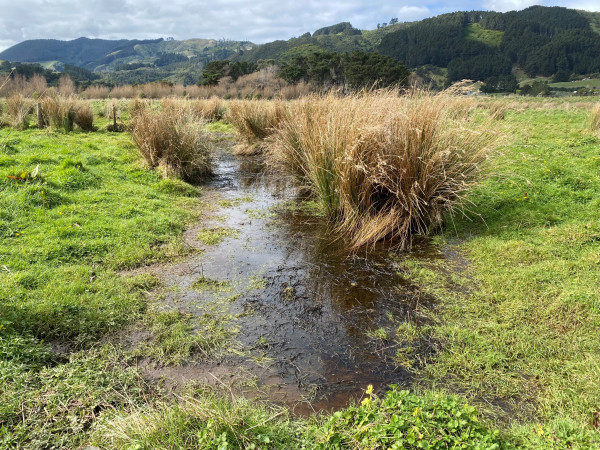 |
 |
| The Wainui and Whareroa Streams run through the park. Wainui means an abundance of water. The park once had extensive wetlands. Since commercial grazing ended, drained wetlands are recovering and restoring themselves through natural processes and there are a lot of wetland restoration projects in progress. | |
The Recloaking Papatūānuku programme includes wetland and duneland plantings, pest plant and animal management works to support the survival and success of restoration plantings, and removal of redundant former grazing area infrastructure to support restoration work access.
 |
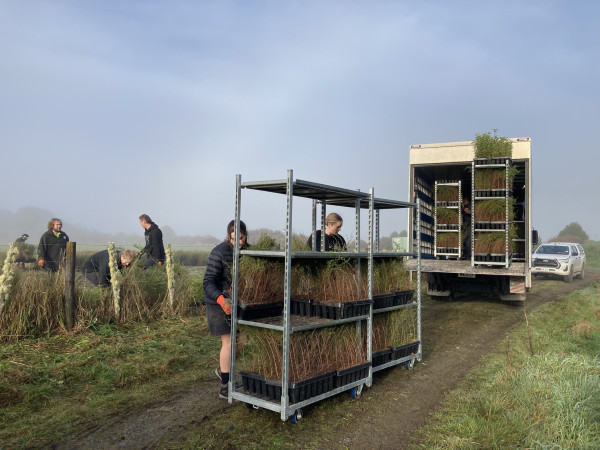 |
| The addition of rabbit proof fencing is to help ensure restoration planting success. Over 65,000 plants are being planted in the wetland areas of the park in 2023 alone. | |
Greater Wellington is also working closely with mana whenua Te Ātiawa ki Whakarongotai and Ngāti Toa Rangatira to co-design restoration plans for the park. The restoration plan should include prioritisation of the various aspects of restoration in the park. There will necessarily be differing levels of restoration across the park, and some areas where natural regeneration will be relied upon with little input from Greater Wellington. Our plans will aim to complement the outstanding work of the volunteer groups in the park.
Wetland and streamside riparian area restoration
Te wai te ora, water is life!
The QEP area, known more broadly as ‘Whareroa’ had extensive wetlands with dune lakes prior to human settlement. They were progressively drained to support human uses such as food and livestock growing from the mid 1800’s. There are a range of wetland types and habitats in New Zealand; the main ones are bog, fen, swamp, marsh, and shallow water (Clarkson and Peters 2021).
Most of QEP’s wetlands are bogs. In bogs water-logged conditions lead to slow plant decomposition which accumulates to form peat. Oxygen-starved conditions mean that dead plant matter decomposes slowly, forming deep layers of black peat. The park has large areas of peat wetlands (peatlands) which have been damaged by years of draining and grazing activities. The key peat forming bog plant in New Zealand boglands is wire rush (Empodisma). This isn’t as widespread as it used to be in the park, but other peat-forming species are present such as sphagnum moss.
The long straight drains you see in the park are not natural alignments of waterways. They were dug to drain low lying wetlands so the land could be used for agricultural activities. Opportunities are being explored to restore the peatlands. Hydrological studies are being undertaken and include shallow monitoring bores, flood modelling and ground water level monitoring. Over time, water levels may be gradually raised slowly and in stages and some of the drains may be able to meander and reform permanent wetland lakes. Runoff from State Highway 1 also enters the park and is filtered via newly constructed wetlands at the northern end. This project is highly complex, with a railway, state highway, power lines, and local homes all nearby the peat soils. Our teams are collecting detailed hydrological data to inform our next steps and support any future consenting process.
A restoration plan developed to guide work to restore the peatlands identifies that ‘This semi-decomposed plant material accumulates as layers of ‘peat’ that over millennia can slowly build up and become many metres thick. Peatlands are the world’s largest natural terrestrial carbon store. At the same time, damaged or drained peatlands can become a major source of greenhouse gas emissions. Rewetting peatland is therefore an important climate change mitigation technique’. Ending commercial grazing and restoring the peatlands of the park is also helping to achieve Greater Wellington’s aim of being carbon positive by 2035. Restoration has multiple benefits.
In the central part of the park, eight ephemeral wetland pockets have been identified as a priority for restoration. This will involve blocking drainage channels to slow water and allow the wetlands to recover, as well as planting of appropriate wetland species. Resource consent has been granted for this project, and we hope to begin restoring these wetlands soon.
Restoration preparation
The aim of restoration work is to re-establish peat-forming species and peat-forming processes. Over time native species will dominate the landscape. An adaptive approach to management will be adopted which includes evidence from monitoring and adapting to ongoing changes as biodiversity is restored.
Some of the peatland areas are currently dominated by gorse. Until we are further down the planning process we will leave the gorse in place. Other preparation work includes hydrological monitoring and modelling.
There are many Toitū Te Whenua Plan actions about restoration and work is ongoing.
For example, A329 identifies ‘Restore native riparian habitat along the full length of all waterways (streams and drains) considering pocket plantings of nursery species for birds’. See the pictures below for examples of progress.
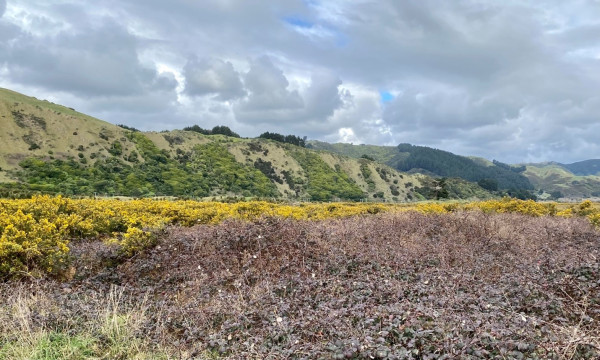 |
|
| Gorse and blackberry are thriving in some parts of the northern peatland. Gorse will be removed, and blackberry sprayed prior to restoration plantings. | |
 |
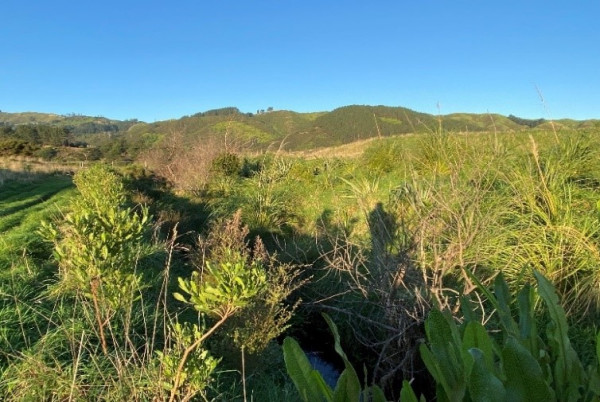 |
| 2019 and 2023 pics of streams. QEP’s former extensive wetlands were drained progressively over many years. Now the riparian areas of the drainage channels are being restored to support freshwater quality and habitat for native birds, animals, fish and invertebrates. The Kāpiti Biodiversity Project also has a Streams Group who are focused on riparian planting and weed maintenance along the Whareroa and Waterfall Stream and their tributaries. The constructed channel drains are deep and currently only allow overflow in significant floods in the northern parts of the park. | |
 |
 |
| From this image taken in September 2019 you can see the natural meander of the Whareroa Stream and the straight drain of the channel previously installed to drain the peat wetland areas. The entirety of the area seen has been identified as wetland and this is apparent every winter when the area floods. This area was previously commercial horse grazing for a horse trekking business. You can see three horses standing in water in the bottom left corner. These wetlands are now being restored via the Recloaking Papatūānuku parks restoration programme. | Mature Whareroa Stream restoration plantings provide shelter within the stream for fish. |
Duneland restoration
It’s not all about wetlands. The park’s coastal and inland dunelands are a diverse ecosystem. Maintaining healthy vegetation and replanting exposed and eroded areas supports dune stability and habitat for native birds and animals. Restoration plantings are occurring across the park's inland dunes via the Recloaking Papatūānuku programme and volunteer works. Dunes near Whareroa Road is continuing and facilities are being relocated inland, including a new Paekākāriki Surf Lifesaving Club building. A Coastal Erosion Plan has been developed for the southern area to support sustainability works. There is still good access to the beach and a range of alternative inland tracks.
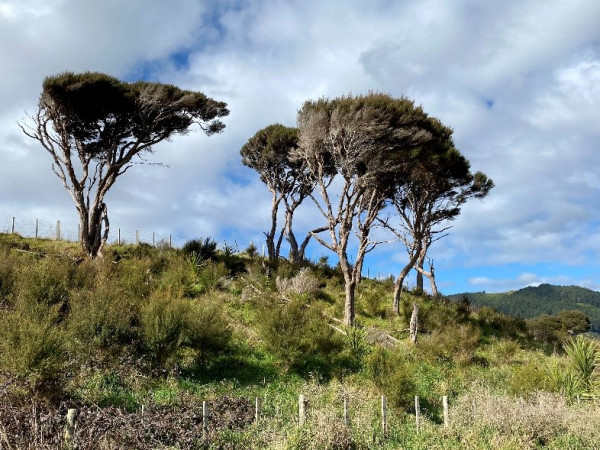 |
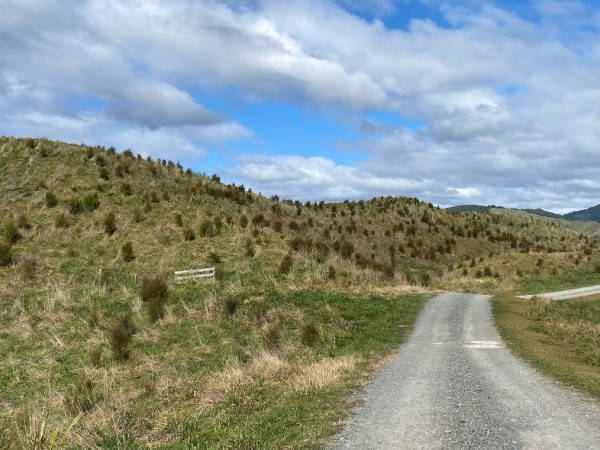 |
| Old kānuka trees and new understory plantings on one of the inland dunes beside the Old Farm Track. The wetland basins in the inland dunes are also being replanted. | |
| Coastal systems are in constant stage of change. Natural processes of erosion have seen areas of dune and the former northern coastal track lost to the sea. |  |
| Beach access in the park via The Esplanade, Raumati South entrance. Coastal erosion here has seen some changes in the track network. | |
 |
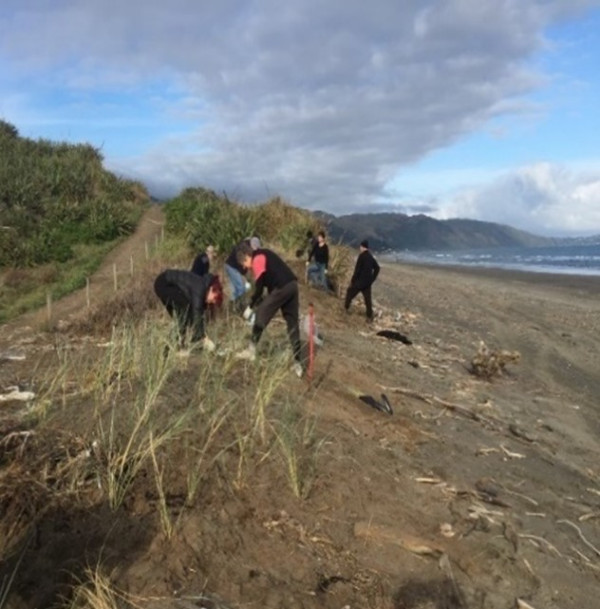 |
| Dune restoration work in progress. | |
Non-native species
Exotic species are present throughout the park. Not all are invasive and some can have an important role in providing habitat and supporting biodiversity. For example, tree lucerne grows fast and provides a good food source for kererū (native wood pigeon). Old eucalyptus and macrocarpa provide nesting habitat for birds and eucalyptus and banksia are a good source of nectar food when flowering. In the past non-wilding poplars have been planting as erosion control in riparian areas.
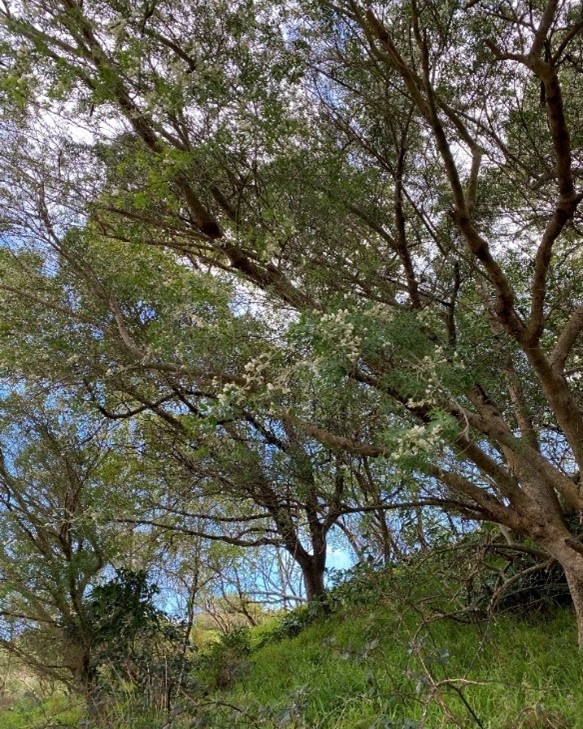 |
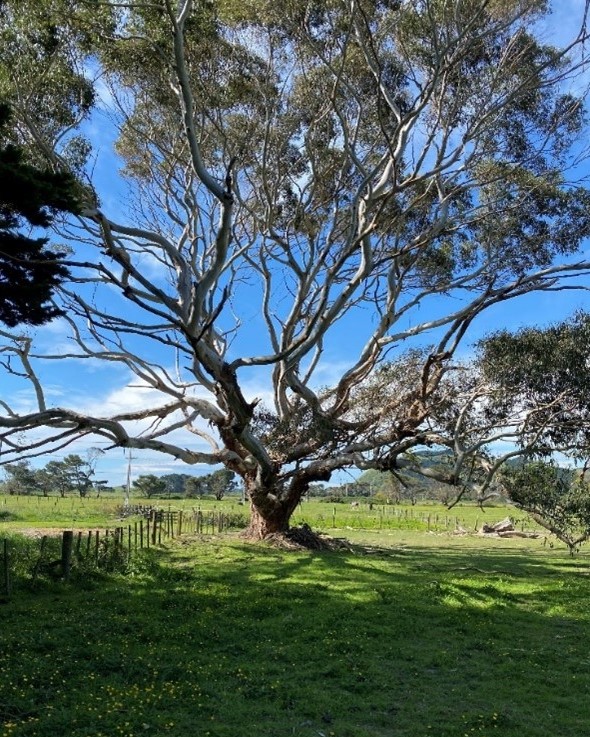 |
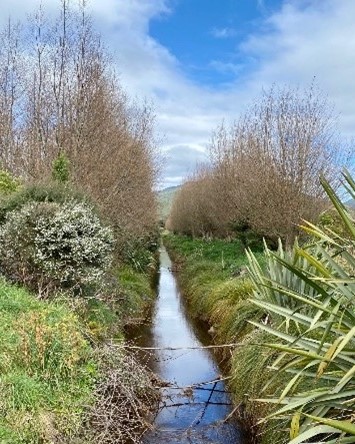 |
 |
| Non-native species in the park offer some habitat value such as winter food for birds, old tree nesting hollows and rapid establishment to reduce erosion on stream banks where vegetation was previously limited. | |
Key Native Ecosystems and biosecurity
The Key Native Ecosystem programme protects and improves the condition of the areas of high biodiversity value in the park. These areas include coastal dunes, the kahikatea forest remnant, and several wetlands which are ecologically important at a regional level.
The parks dune system is the largest and most un-modified area of dunes in the region, and the bush remnant is a good example of the kahikatea-pukatea forest that once clothed much of Kāpiti Coast.
The programme includes weed control undertaken annually, ongoing pest animal control (e.g. rabbits) and revegetation plantings. These have been focused on the northern wetland and the foredunes but are now expanding across the park with the Recloaking Papatūānuku parks restoration programme, funded first by Council’s Low Carbon Acceleration Fund, then the Long-Term Plan.
 |
 |
 |
| Weed management and pest animal control is an essential part of restoration work in the Whareroa/ QEP area. Manual and remote control mulchers are used, manual pulling of weeds such as boneseed and ongoing pest trap management. Many volunteers help out with pest plant and animal work. Greater Wellington is grateful for all the work so people do to support the environment and recreation activities in our wonderful Regional Park network. | ||
Fire threat management
Toitū Te Whenua Plan action A337 identifies ‘Develop a fire management ‘tactical response plan’ to guide ongoing fire threat management work e.g. firebreaks, ‘green vegetation’ firebreaks, defensible space, progressive restoration of native vegetation’.
A fire threat management plan was developed and works so far to implement it includes:
- Removal of pine trees at the northern end of the park
- Maintenance of mown areas beside tracks for access
- Relocating the pony club licence area which includes grazing to a more sustainable area (off wetlands and steeper dunelands) where grazing and mowing/ hay cutting reduces seasonal fuel load and provides a lower vegetation fire break
- Signs prohibiting lighting of fires, particularly in the beach areas which are the main source of people lighting fires and leaving them uncontrolled.
- Restoration of wetlands park-wide
- Native vegetation restoration to support seasonal fire threat reduction, particularly planting of less flammable species.
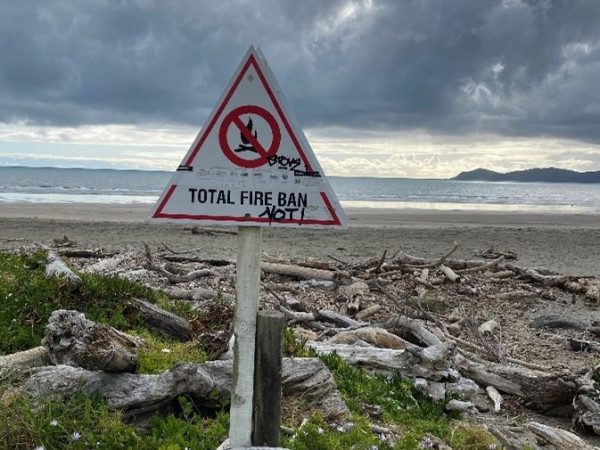 |
| Records show that the main source of fire ignition has been by people lighting fires on the beach. To protect the park please protect the park and don’t light any fires on the beach. Use a portable gas BBQ for your picnic. |
 |
 |
|
Pine trees are highly flammable and not appropriate near adjoining residential areas. Pines within the park near Rainbow Court have been removed and the area will be replanted with natives. In other areas or parks some pines are left to decline naturally (senesce) where they don’t pose a significant fire risk because they can offer habitat value for native birds. For example, Kākā have been sighted in the park and parrots like to nest in old tree hollows found in mature and decaying trees. |
|
In Toitū Te Whenua goals set great directions for working with mana whenua in a partnership approach and collectively together. This approach is being embodied in QEP and the broader Whareroa area.
Goal 3 is ‘A variety of landscape settings to be preserved, enhanced and where appropriate interpreted for visitors’.
Goal 4 is ‘Collectively we work together in mahi tahi partnerships, as kaitiaki guardians, nurturing strong mauri and enhancing parks for current and future generations’.
Goal 5 is ‘Working collaboratively and consistency with others, following best practices, we enable learning and build strong partnerships to deliver more conservation and recreation benefits for parks, people and communities’.
A partnership approach with mana whenua is evolving via the Art Confederation. The Confederation includes mana whenua Ngāti Toa Rangatira, Te Atiawa Whakarongotai and Ngāti Raukawa. In the central area of park ‘Te Pātaka Rongoā o Whareroa’ is a 4.6 hectare restoration planting site managed by the Te Pātaka Rongoā Collective and supported by planting, learning and education work facilitated by the park rangers. The park is an important place for mana whenua. The Te Pātaka Rongoā is a place of healing the whenua and giving back for mokopuna and future generations.
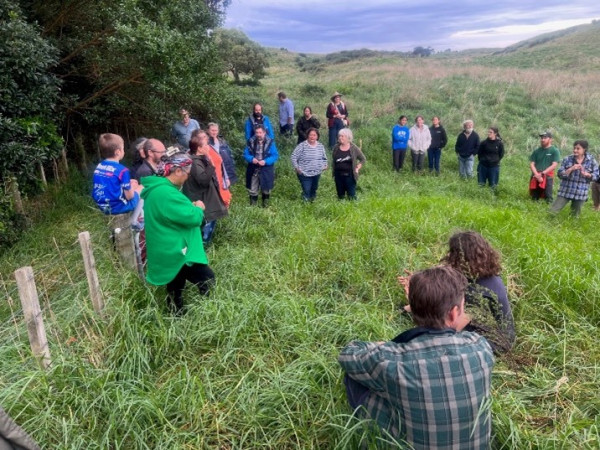 |
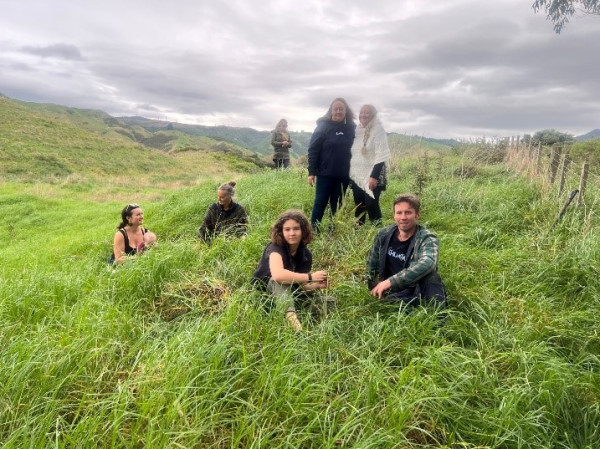 |
|
The Art Confederation includes mana whenua Ngāti Toa Rangatira, Te Atiawa Whakarongotai and Ngāti Raukawa. The Pātaka Rongā Collective planting area in the park is an important place of learning in the park. A celebration of wetlands was held in May 2023. Hine i te Huhi is a central Atua of the wetlands. She is officially offering us all a wero. To actively recognise her important role as the mediator between her siblings Tane, Tangaroa and Hinemoana. |
|
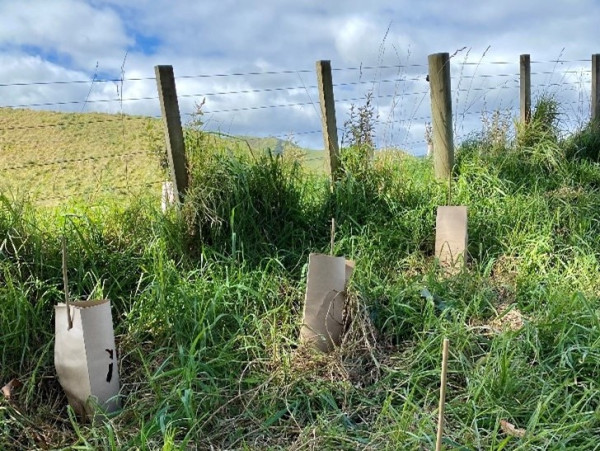 |
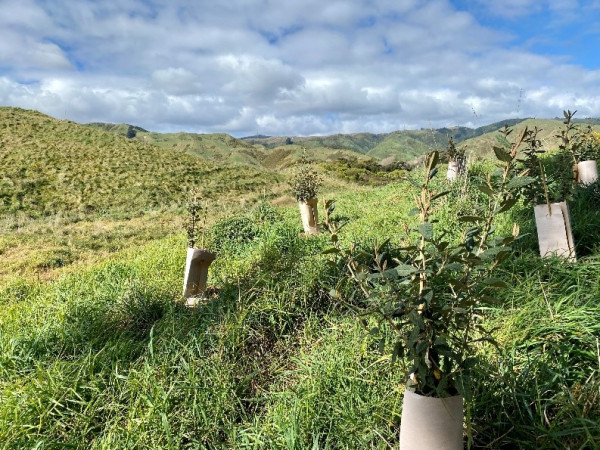 |
| Te Pātaka Rongoa area plantings | |
 |
|
The Kāpiti Biodiversity Project in collaboration with other volunteer groups has been working in the park for many years and have been successful with bringing significant grant funds to support restoration work. A $276k grant was obtained by the group from the Wellington Community Trust for several restoration projects within the park and broader catchment. This includes restoration of central area wetlands, a project called the ‘1000 Totara’ to restore a duneland area, significant riparian restoration works, wetland restoration in Paekākāriki near the railway line and an area of planting area by the Whareroa Guardians in neighbouring Whareroa Park managed by DOC. The overall grant works include site preparation with weed removal, pioneer plantings, weed maintenance, riparian area works and enrichment plantings. Works are being undertaken by volunteers, consultants, and contractors with the Greater Wellingtons support.
The ‘1000 Totara’ restoration project within the park north of Whareroa Road and west of the Old Farm Track includes plants grown in the Te Rito nursery in Porirua and sourced from local seed. Over 1000 totara and 1200 Akeake plants have started the restoration of this former grazed duneland area. This will be followed by a second planting of another 1000 totara in 2024, also grown by the Te Rito nursery and then a further 1000 after that in 2025. Akeake are a pioneer plant and thrive in dry conditions so they are being planted on the drier duneland ridges. The wetland basins within the duneland are being restored by other volunteer project works.
There is also a direct seeding trial (contracted to Red Tree) which includes 10-20,000 locally sourced seeds collected by volunteers and planted directly at a rate of 5-10,000 seeds per hectare. The area was prepared, and seeds were put in divots across this restoration area in June 2023. The overall budget for these works is $65,000 and it continues into 2024. It's adjacent to the Te Pātaka Rongoā Collective restoration area.
Another project in the park funded from the Wellington Community Trust grant is the ‘Rewetting Peatlands’. It focuses on a 65-hectare area south of Waterfall Stream which is in the central northern area of the park. The project includes water testing, resource consent and associated requirements including consultant advice, construction of small dams on drains to support the re-creation of wetlands, plantings of wetland species and weed maintenance works. The design proposed will keep more rainwater in the peat and but allow stream flood water to move through. It has an overall budget of $114,00 and is expected to be completed in 2024. These works are supported by other wetland restoration works nearby undertaken via the Recloaking Papatūānuku parks restoration programme.
Other grant funds for park projects include enrichment plantings of ‘1000 Kahikatea’ and ‘Wetland Acceleration’. The Kahikatea restoration planting project includes collecting local seed, growing at Te Rito nursery and plantings in 2025. The Wetland Acceleration project focuses on returning three to five wetland species which are beneficial to restoration of wetland biodiversity. This project is being supported by advice from Greater Wellington’s ecologists and others.
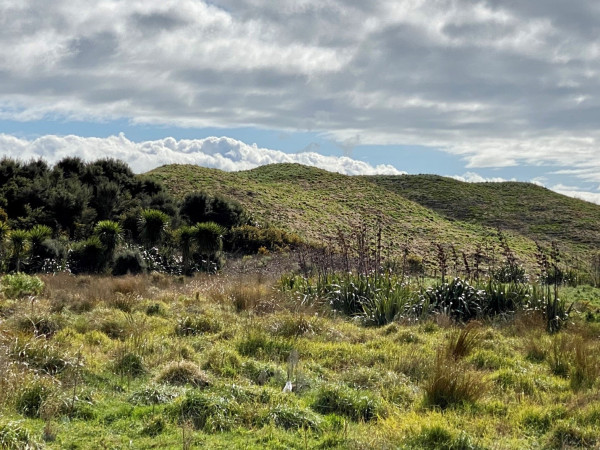 |
| The 1000 Totara Project by the Kāpiti Biodiversity Group is really 3000 Totara over three years and other plantings. Watch the park landscape transform with all the restoration mahi going on to help Papatūānuku, mother nature recover. |
 |
The park Nursery Group is a volunteer group growing and planting thousands of plants in the park and making a huge contribution to the restoration effort. Many volunteers work across restoration projects in the park and in the surrounding catchment including the Kāpiti Biodiversity Project grant funded works detailed above. Plants are also grown in the nursery for the Te Pātaka Rongoā restoration area.
 |
 |
 |
 |
|
There has been a huge change in the look and feel of the park landscape since commercial grazing ended and the focus shifted to restoration and recreation activities after Council adopted Toitū Te Whenua Parks Network Plan in December 2020. Left: stock grazed wetland and fences. This area of park was closed to public access to support the grazing licence. Right: fences have been removed, the park is fully open for recreation activities and wetlands and dunelands are being restored with the help of many people and Council’s Recloaking Papatūānuku restoration programme. |
|
|
|
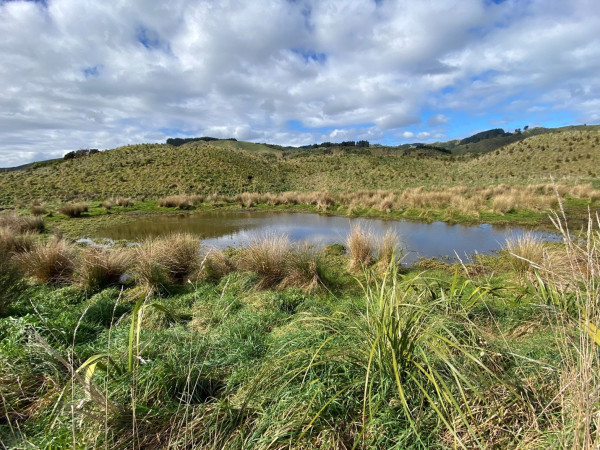 |
| Maclean Trust plantings include dune wetlands between the Te Ara o Whareroa cycle trail and the Old Farm Track. These areas can be explored now, but further walking and riding track enhancements for access are planned. | In the northern part of the park there are significant wetlands within the dunes. This is one of the Maclean Trust restoration areas. |
Restoration progress since commercial stock grazing ended
Commercial stock grazing ended on the park in 2020 when the licensee exited. The focus since then has been on opening full public access for recreation activities, development of a new Poplar Avenue entrance, restoration of wetlands and dunelands. A lot of pest plant work is in progress. This part of the park also has the extensive Maclean Trust restoration plantings. In 2022/23 over 65,000 native trees, shrubs and grasses have been planted in the park.
Progressively ending stock grazing in regional parks has helped contribute to a significant reduction in Greater Wellington’s corporate greenhouse gas emissions. Restoration work supports multiple benefits including carbon sequestration, restoration of ecosystem health, mātauranga values and landscape amenity for recreation activities.
 |
 |
| QEP wetland with stock grazing licence in 2018 and the same area after natural and active processes of restoration in 2023 | |
Kāpiti Stables trekking and grazing licences and Kāpiti Pony Club
Toitū Te Whenua Actions A340 states Identify a range of sustainable land use improvements to minimise impacts on soil and water health from recreation related horse grazing and incorporate changes into licences as they are reviewed.
Action A328 identifies Progressively reduce grazed areas classified as originally being wetland and over time restore hydrological functions and native flora following original habitat classification, water sensitive design, hydrology best practice and science expert advice. Progressively re-wet peat land to stop further degradation and undertake riparian planting throughout the park.
Prior to 2023 there were two horse grazing related licences in QEP. Kāpiti Pony Club based at the northern end of the park, and Kāpiti Stables horse trekking business which included some casual horse grazing opportunities near the Mackays Crossing entry area. Kāpiti Stables utilised the old black barn beside the Wellington Tramway Museum. The conclusion of the agreements provided the opportunity to determine if more sustainable options are available which better support the Toitū Te Whenua vision of ‘Restoring healthy ecosystems for the benefit of people and nature’.
To support the vision, Toitū Te Whenua policies and rules identify that commercial stock grazing will be phased out in regional parks and that horse grazing is a high impact activity.
Licensees identified issues with flooding, poor pasture, and security. After an extensive investigation process by Greater Wellington planners, scientists, biodiversity officers, Park Rangers, the licensees and others in 2022, a new more sustainable area for club activities and grazing was found for the Kāpiti Pony Club and their licence was renewed. The club continues to use some of their previous licence area including their green barn near Poplar Avenue and they have a new higher and drier ground area further into the park, which is more secure and avoids wetlands and steeper dunelands.
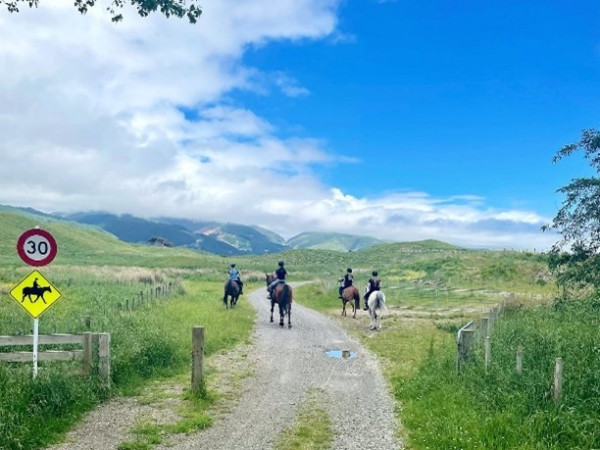 |
 |
| The Kāpiti Pony Club area includes the large flat paddock beside Te Ara o Whareroa cycle trail and an adjoining low dune slope paddock. Horse grazing in these paddock keeps the grass down and offers a low vegetation buffer for the park restoration areas should a fire be lit to the northwest of the park. | |
The park remains a great destination for casual riding and eventing. Several facility enhancements have already taken place, and more are planned, including a new northern park entrance with area for horse floats.
The former horse grazing wetland area of park is now being restored via Greater Wellington’s Recloaking Papatūānuku Parks Restoration Programme which is supported by mana whenua, conservation and community groups. Approximately 50% or 8 hectares of the former Kāpiti Stables licence area has already been planted with native plants including wetland species. A planting plan developed by an ecologist guided plant selection.
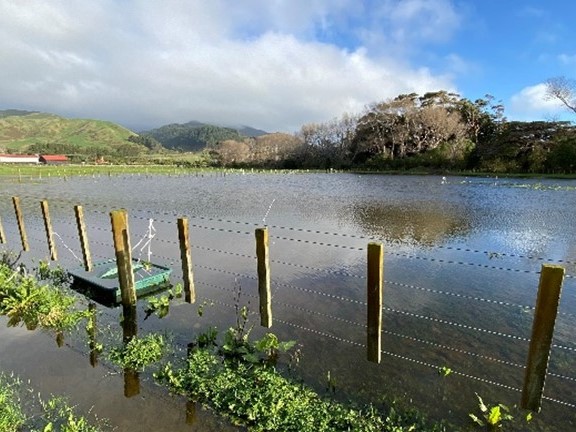 |
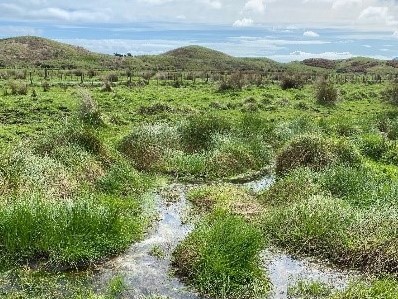 |
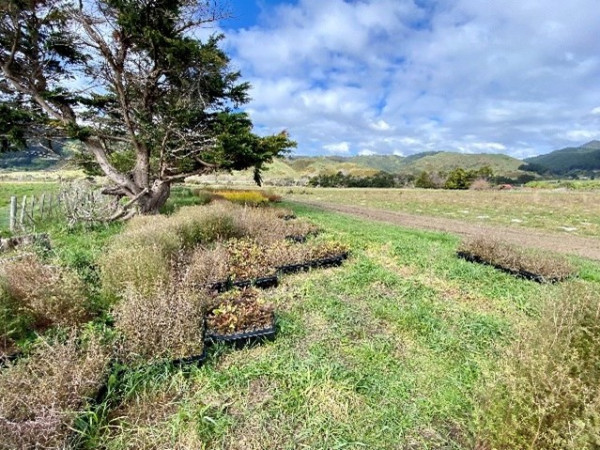 |
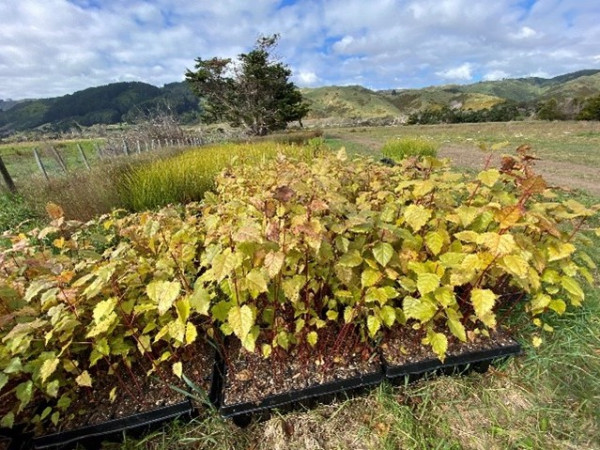 |
| Two wet winters saw extensive flooding of drained wetland areas of the Kāpiti Stables gorse trekking business. A natural spring was also rediscovered within the grazing area. It is now protected, and restoration works are planned. In 2023 over 65,000 plants have started restoration of this area supported by pest animal management work. | |
Get in touch
- Phone:
- 0800 496 734
- Email:
- info@gw.govt.nz

